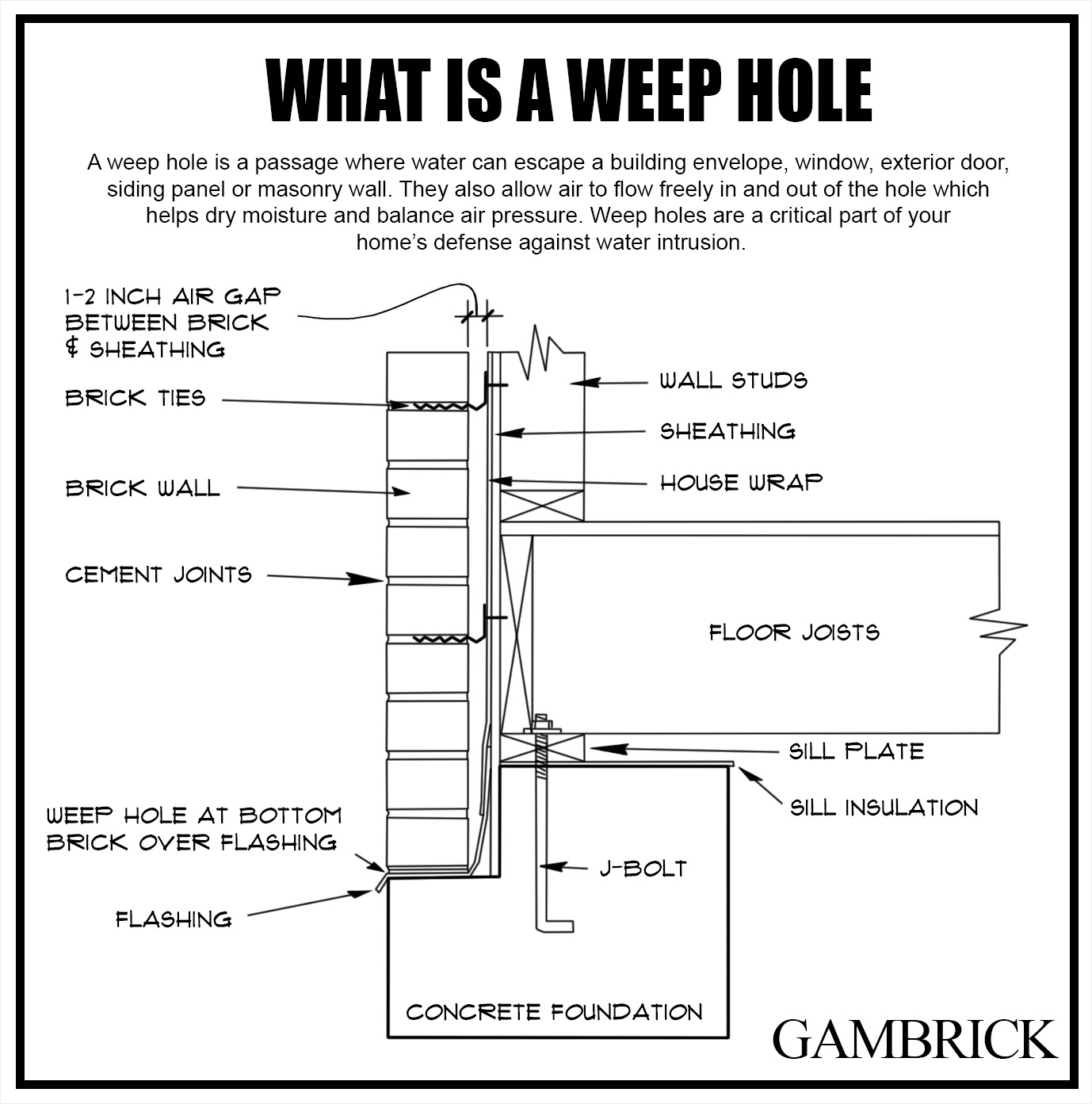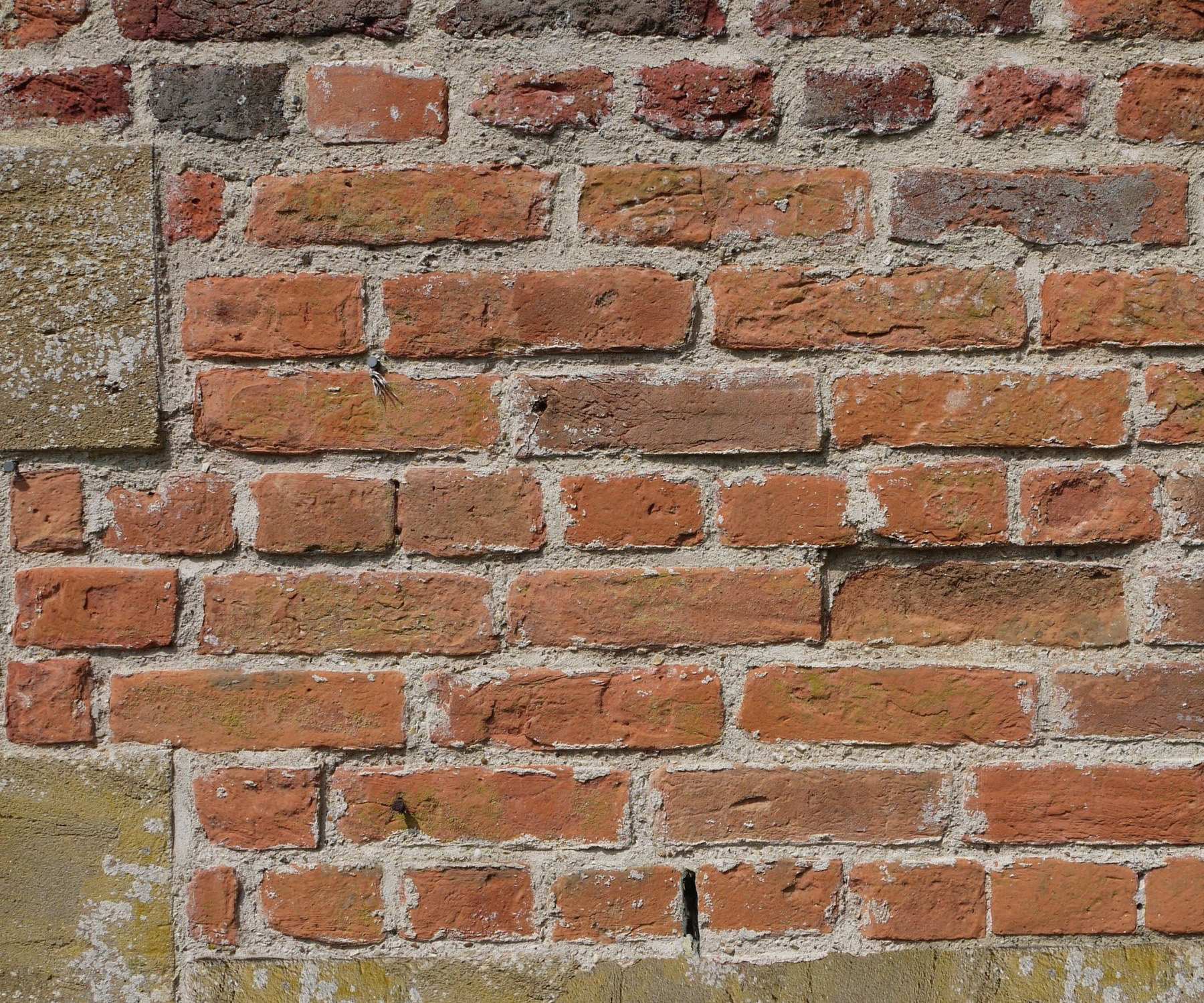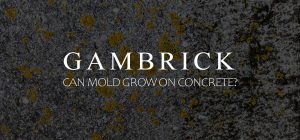What Is A Weep Hole & Are They Necessary?
A weep hole is a passage where water can escape a building envelope, window, exterior door, siding panel or masonry wall. They also allow air to flow freely in and out of the hole which helps dry moisture and balance air pressure. Weep holes are a critical part of your home’s defense against water intrusion. They’re used in places that collect moisture. When water builds up it needs a place to drain. Weep holes provide the drain. Without them, water could eventually cause mold and mildew growth or structural damage. Damp areas need fresh air to dry out properly. Weep holes allow air to flow in and out which helps wet areas stay dry. Lastly, they help balance the air pressure behind solid brick and stone walls that trap air behind them.
It’s very important for a home to stay dry. Water is one of the leading causes for home damage, mold and mildew growth. It takes multiple products working together to keep water out of the home. Weep holes are an integral part of that system. They protect against water penetration and allow the home to “breathe”.
It’s relatively easy for water to penetrate behind a home’s exterior cladding. As it builds up it needs a way to drain. Weep holes are the drain. They’re strategically placed in all sorts of places you probably didn’t know about. Things like siding panels, windows, doors and trim all have weep holes built in by the manufacturer.
In custom built areas, like brick walls, weep holes are included by the builder to drain water that collects behind the wall and to promote good airflow.
Without weep holes, a home would have a much harder time staying dry. They would be more prone to water damage, mold and mildew growth.
What Is The Purpose Of Weep Holes?
The purpose of weep holes is to allow drainage, promote airflow and balance air pressure. When water builds up on the exterior of a home, it needs a place to drain. Weep holes are the drain. They also allow air to flow freely in and out of the hole which speeds up drying and helps prevent mold and mildew growth. Without weep holes, it would be much easier for mold and mildew to grow and for structural damage to occur.
Here are a few areas you’ll find weep holes and why they’re there:
- Brick & Stone Walls: Weep holes are included at the base of brick & stone walls to allow water to drain out from behind the wall. They also allow air to flow in and out which promotes drying. Lastly, airflow helps balance air pressure between the wall and home.
- Windows & Exterior Doors: Manufacturers include weep holes in their windows and doors to allow water to drain. With the holes water could build up, leak into the house or damage the window/door.
- Siding: Manufacturers include weep holes in siding panels to allow drainage. Without them water would sit inside the panel which could eventually damage them or leak into the house.
It’s very important to keep both the inside and exterior of a home dry. Lots of products are used together to accomplish this. This includes siding, flashing, trim, windows, doors, roofing, etc. Weep holes are an important part of that system.
When water builds up on any exterior material, it can eventually cause damage or a leak. A weep hole allows the water to drain and promotes air flow which keeps the house dry.
Weep Holes Provide Ventilation & Drainage
Weep holes in a brick or stone wall provide not only drainage but also ventilation. Brick and stone siding is built with a small 1 inch gap between the home’s wood sheathing and the masonry wall. Weep holes lead to this gap. Brick, stone, concrete and cement are all very porous which means water can absorb into and through them. It eventually makes its way to the backside of the wall and drains down the 1 inch gap. Because of the gap and the weep holes, water stays off the home’s wood frame. This prevents water damage like rot.
Fresh air enters into the gap through the weep hole to provide ventilation.This helps reduce moisture, dries out the bricks and prevents mold growth.
Most weep holes are only about 4⅝ inches deep. Standard bricks are 3⅝-inch-wide plus the one inch air gap which makes 4⅝ inches. But weep holes can be deeper if you build the wall with a wider gap or use a thick stone or concrete to build the siding.
Wood sheathing is covered with a moisture resistant membrane also called a vapor barrier. Any moisture that touches the sheathing should run down and away from the wood. This water would also collect and drain out of the weep holes.
Both a vapor barrier and weep holes work together to protect the home’s structure from water damage, mold and mildew growth.
Weep Holes Use Flashing
The purpose of flashing is to prevent water from going where it can cause damage. Flashing is solid an non-porous so moisture can’t penetrate through it. it’s also water resistant so constant exposure to water won’t damage or corrode it. Either sheet metal flashing or a butyl rubber membrane is installed against the house, in the air gap between the brick and sheathing, to direct water that penetrates through the bricks to the weep holes.
In some cases the flashing is visible beneath the lowest row of bricks. If metal flashing is used, it’s usually fold down over the foundation an inch or so.
Behind the bricks, flashing connects to the sheathing at an angle which pitches into the weep holes. This ensures any moisture that collects and runs down the sheathing or bricks will hit the flashing and drain through the weep holes.
Weep holes are always be installed on the bottom row of bricks directly above the flashing.
Weep Holes In Brick
One of the most common types of weep holes are found at the bottom of brick walls. Masons build them into the wall to drain water that collects behind the brick. Bricks and cement are porous materials that absorb water. The water passes through the brick and collects on the backside of the brick wall. Without a place to drain it would collect in the space between the brick and house sheathing. Weep holes provide a drain for the water. They also allow in fresh air which dries the area. This helps prevent water damage and stops mold and mildew from growing behind the brick.
There are a few different types of brick walls that all use weep holes:
- Siding: Brick siding is built against the house sheathing. A small air gap is left between the house sheathing and brick. If water has no way to drain it will collect at the base of the wall and potentially cause damage to the house or grow mold. Weep holes provide drainage and allow in fresh air which dries the brick and sheathing.
- Retaining Walls: Brick retaining walls that hold back dirt or stone need a way to drain water pressing against the brick. Weep holes drain this water which releases pressure on the wall.
- Structural Brick: Structural brick walls were built in older homes using multiple layers of stacked bricks. Because there’s no wood framing, moisture can pass right through the wall and into the home. Weep holes are placed inside the wall to drain water before it can absorb into the house.
When building with brick, it’s important to have a plan for dealing with water. Weep holes provide a drain and allow fresh air circulation which helps dry the bricks.
Weep Holes Above Doors & Windows
Brick, stone and other masonry walls install weep holes above doors and windows. The purpose of these weep holes is to stop water from draining onto the door or window’s framing. Typically above window and door frames there is also flashing or a drip edge to divert water away from the opening. When brick, stone or other masonry siding above a window or door absorbs moisture, it can drain down directly onto a door or window opening. Flashing and weep holes drain the water away from the opening which keeps it out of the house and away from the home’s wood framing.
Doors and windows are penetrations through the home’s exterior envelope. If water penetrates through or behind a window or door frame, it could hit the home’s wood framing or enter into the house. Weep holes and flashing prevent this from happening. Any water held inside the masonry above a window or door will drain down onto the flashing and out of a weep hole.
Weep holes above windows and doors also allow fresh air in which helps keep the space between the masonry and sheathing dry. This helps prevent water damage, mold and mildew growth.
Not all codes require weep holes above windows and doors, but they’re a good idea to include. If water works its way onto or behind a window or doors framing, it could hit the home’s wood frame causing potential rot, structural damage, mold or mildew growth.
What Is A Weep Hole In A Window?
Weep holes are small slit shaped drains built into a window frame by the manufacturer. They help drain water down and away from the window frame and sill. Draining water away from the window helps prevent leaks into the house and wall frame. They also help prevent damage to the house sheathing, trim and framing as well as preventing mold and mildew growth.
If water gets behind the window frame, it can potentially reach the home’s wood framing which is untreated. This can cause rot and mold growth.
If your windows have wood sills, sitting water can slowly rot them. Weep holes drain water off the sills which helps protect them against water damage. Wood sills are a common place to find rot, mold and mildew so keeping them dry is very important if you want them to last.
Make sure painters don;t paint or caulk over a wood windows weep holes. Blocking your windows weep holes can lead to water damage over time.
What Is A Weep Hole In A Door?
Weep holes are small slit shaped drains built into an exterior door frame by the manufacturer. They help drain water down and away from the door so water can’t leak into the house or get behind the frame. Draining water down and away from the door helps prevent leaks into the house and wall frame. They also help prevent damage to the house sheathing, trim and framing as well as preventing mold and mildew growth.
If water gets behind the door frame, it can potentially reach the home’s wood framing which is untreated. This can cause rot and mold growth.
Weep Holes In Concrete
Because concrete is a very porous material, it absorbs water. Any type of masonry wall which uses cement or concrete in its construction has to deal with moisture absorbing into and through the concrete. Water can seep through the wall and then run down its backside. This is why many basements have french drains around the entire perimeter. They catch and drain water that runs through the concrete and down to the floor. If water cannot drain, it puddles inside the wall and potentially damages your home’s structure.
Weep holes are created as a drain for water. They give water a place to go while allowing fresh air to circulate which helps dry the concrete.
Weep holes built along side a house, as with brick or stone siding for example, aren’t open all the way to your home’s interior. They only go as deep as the exterior sheathing. They’re meant to drain water trapped between the back of the wall and the house.
Concrete retaining walls that hold back dirt or stone use weep holes to drain water that builds up against the back of the wall. This alleviates pressure against the wall.
When working with concrete, it’s a good idea to use weep holes as a way to drain water and allow air flow.
Are Weep Holes Necessary?
Yes, weep holes are a necessary part of a home’s defense against water penetration. One of the leading causes of home damage is water. It causes rot, deterioration, mold and mildew growth. All sorts of products like windows, exterior doors, siding, flashing, tape, house wrap, roofing, caulk, etc. are used together to keep a home dry. Weep holes are a necessary and very important part of that system. When water collects and builds up, it needs a place to drain. Weep holes are the drain.
In addition to allowing drainage, weep holes promote good airflow. Air can freely flow in and out of the hole which keeps building materials dry. Fresh air also helps control mold and mildew before it can grow.
Without weep holes, moisture could collect and build up in lots of different places. It can then cause damage to materials or leak into the home. This is why manufacturers include weep holes on almost all exterior products. Things like windows, exterior doors, siding and trim all have weep holes built in at the factory.
In custom built areas, like brick and stone walls, weep holes are included by the mason. They allow drainage for water that builds up behind the wall and promote airflow which keeps the wall dry. They also help balance air pressure in the space between the wall and house.
There’s no doubt that weep holes are a very necessary part of a home’s construction. Without them, your house would be more prone to water damage, mold and mildew growth.
What Happens If You Cover Up Weep Holes?
You should never cover up a weep hole. They’re a critical part of your home’s drainage system which keeps water from building up in unwanted places. If water can’t drain properly, it can eventually cause rot, deterioration, structural damage, mold and mildew growth. In winter, built up water can freeze which can cause cracks. Weep holes provide drainage for things like siding panels, windows, exterior doors and brick walls. They also promote airflow in hard to reach places that have trouble drying out.
If you cover up weep holes the result can be rot, deterioration, structural damage, mold and mildew growth.
Covering up a weep hole is no different than blocking any other drain in your home. Imagine what could happen if your shower or sink drain was blocked. If water has no way to drain, it will collect and eventually cause damage to your home.
Can Water Come In Through Weep Holes?
Yes, water can come in through a weep hole but not enough to do any damage. Weep holes are located at the bottom of brick and stone walls which allows water to flow down the wall and out the hole. If a small amount of water works it’s way into the hole it will simply drain back out again. The base of the wall where weep holes are located is typically masonry or well flashed so no damage can be done by water.
Weep holes located on windows, exterior doors and siding panels are designed to drain down. If water should splash up through the hole it will eventually drain out causing no damage.
You don’t have to worry about water coming in through a weep hole. They’re very small and any water that comes in will drain back out again.
Can Mice Enter Through A Weep Hole?
Yes, if a weep hole is large enough mice and other pests can work their way in through the hole. For this reason it’s important to make the hole as small as possible. Generally they’re no larger than the with of a brick joint which is 3/8 inch. A steel weep hole cover can be installed into the hole to keep mice and other pests out.
Do Weep Holes Let In Cold Air?
Whether or not weep holes let in cold air depends on where the hole is. If the weep hole is at the base of a brick or stone wall then yes, they let cold air in which helps dry the inside of the wall. But if the weep hole in built into a window or exterior door then no they don’t. The weep holes in windows and exterior doors are drains that divert water down and away which prevents leaks.
Is It OK To Put Steel Wool In Weep Holes?
Yes, it’s OK to put stainless steel into a weep hole at the base of a brick or stone wall. The steel wool will stop mice and other pests from entering the hole but won’t stop water or air flow. Steel wool is actually a very good way of covering a weep hole because it has fine holes which also keeps out bugs. Steel weep hole covers have larger holes which block large pests but not small bugs.
Another benefit of using steel wool to block your weep holes is that you can remove and clean it periodically.
Summary: What Is A Weep Hole & Are They Necessary?
A weep hole is a passage where water can escape a building envelope, window, exterior door, siding panel or masonry wall. They also allow air to flow freely in and out of the hole which helps dry moisture and balance air pressure. Weep holes are a critical part of your home’s defense against water intrusion. They’re used in places that collect moisture. When water builds up it needs a place to drain. Weep holes provide the drain. Without them, water could eventually cause mold and mildew growth or structural damage. Damp areas need fresh air to dry out properly. Weep holes allow air to flow in and out which helps wet areas stay dry. Lastly, they help balance the air pressure behind solid brick and stone walls that trap air behind them.
It’s very important for a home to stay dry. Water is one of the leading causes for home damage, mold and mildew growth. It takes multiple products working together to keep water out of the home. Weep holes are an integral part of that system. They protect against water penetration and allow the home to “breathe”.
It’s relatively easy for water to penetrate behind a home’s exterior cladding. As it builds up it needs a way to drain. Weep holes are the drain. They’re strategically placed in all sorts of places you probably didn’t know about. Things like siding panels, windows, doors and trim all have weep holes built in by the manufacturer.
Without weep holes, a home would have a much harder time staying dry. They would be more prone to water damage, mold and mildew growth.
If you have any questions or comments about weep holes and why they’re necessary email any time.























